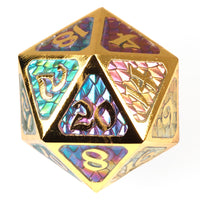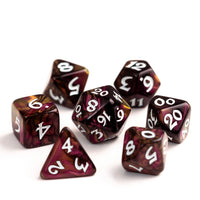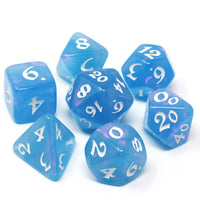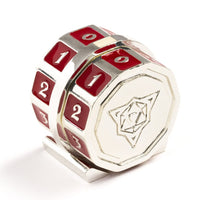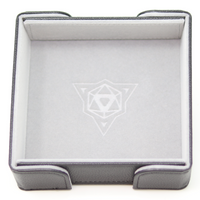You may be wondering
WHAT ARE DND DICE?
As the dice tumble from your hand, multiverses of possibility resolve into an outcome. Real life role players and the fantasy characters they play are linked together by their dice.
Dungeons and Dragons made these seven shapes an iconic team. Today, the use of a DND dice set has become a cornerstone not just in D&D, but in many other tabletop role-playing games as well.
This guide will demystify these dice, breaking down each one's purpose and meaning. Advance, brave scholar, drink deeply from the fountain of knowledge:

Which 7 dice make a set?
To start playing, you only need one of each: the D4, D6, D8, D10, D12, and D20, but standard 7-dice sets also include a second D10 which is used for percentile rolls. Gamers often prefer to have multiples of some die in order to roll pools of dice, such as 6d6 in one roll instead of repeating an individual d6 roll six times.

What are their common uses?
The D4, D6, D8, D10, and D12 each play their crucial roles in shaping the results of weapon damages, magic spells, and healing effects.
The D20, on the other hand, often decides the success of your character's actions. Whether your hero is attempting a daring leap, a stealthy pickpocket, or a powerful spell, it's the roll of the D20 that determines the success of their attempts. The beginner may hope for only high rolls, but knowing how to role with your rolls, whether good or bad, is the hallmark of the skilled gamer.

Icosahedron
The Mighty D20
The towering titan of Dungeons & Dragons, the D20, stands taller and rolls further than its counterparts, thanks to its near-spherical shape. Constructed from equilateral triangles, it's the die you reach for when the success of your character's endeavors hangs in the balance. Whether it's for attacks, saving throws, skill checks, or ability checks, each roll of the D20 carries a 5% chance for each result.
In essence, the D20 is the "decider" in the D&D dice family. If you're interested in a deeper dive into the intricacies of the D20 rolls, feel free to explore our dedicated page: All about D20s.
d20 Examples

Dodecahedron
The D12
The D12, with its twelve-sided design, is a force to be reckoned with. With each face shaped like a pentagon, this die is often the go-to for calculating the damage inflicted by the hefty weapons wielded by formidable characters like the raging barbarian.
These dice also stack very well for those long dice-stacking intervals between combat turns.

PENTAGONAL TRAPEZOHEDRON
The D10
A standard 7-dice D&D set actually boasts two ten-sided dice: a D10 and a "percentile die". The D10 ranges from 0 to 9, while the other leaps from 00 to 90, marking increments of ten.
These two dice are rolled together to form a 'percentile' roll or the D100. To perform this, you roll both dice and combine their values. However, there's a twist: a roll showing double zeros doesn't equate to zero, but rather, it represents the elusive 100.
On its own, a D10 is sometimes used for damage dealt by large weapons like a two handed sword or halberd, for higher level spells, or to determine added hit points when a paladin or fighter goes up a level.

OCTAHEDRON
The D8
Each of its faces is a perfect triangle, forming a shape that resembles two pyramids fused at their bases.
A longsword wielded in one hand or a rapier inflicts damage calculated by a D8 roll. It's also vital in the hands of a spellcaster. For instance, the 'Cure Wounds' spell, a staple healing spell for many classes, involves a D8 roll to determine the hit points restored. Similarly, some damaging spells like 'Shocking Grasp' or 'Ray of Frost' also rely on D8 rolls for their effects.
Classes like the Cleric, Druid, Monk, and Warlock all use a D8 to calculate their new hit points when they advance in level.

CUBE
The D6
The standard cube shape die found in most boardgames is also used in D&D.
Many D&D players have a collection of D6s at their fingertips for scenarios that demand multiple dice. For instance, during the character creation process, a player might roll 3D6 to determine their character's attributes in the original rules. In many modern versions of D&D, the process has evolved to rolling 4D6 and discarding the lowest roll.
In gameplay, it is frequently used for weapon damage, especially for common weapons like short swords or maces. It's also often the die of choice for many spells, such as the iconic 'Fireball', where a wizard may find themselves rolling multiple D6s to determine the fiery spell's damage.
The D6 is used in determining hit points for Wizards and Sorcerers, who roll a D6 to calculate their new hit points when they gain a level.

TETRAHEDRON
The D4
The D4, also known as the caltrop, is a remarkable die in its own right. Who among us hasn't imagined stepping on a D4 barefoot?
This little pyramid plays an outsized role in the game. With its values ranging from 1 to 4, it offers a low degree of variation, resulting in an average roll of 2.5. This makes it the perfect die for situations where you want relatively consistent results, or when the impact of luck needs to be minimized.
Damage rolls for small, light weapons, such as daggers or slings, often rely on a D4. The lower range of outcomes reflects the limited damage such weapons can inflict, providing a level of realism to the combat scenarios.
Frequent Questions about D&D Dice
If your question isn't answered here, please send it to service@dieharddice.com - we'd love to hear from you!
In Dungeons & Dragons, advantage and disadvantage are significant game mechanics. When rolling with advantage, you roll two D20s and take the higher result. This could be due to a beneficial spell, a special ability, a magical item, or the Dungeon Master's discretion based on the circumstances.
On the other hand, rolling with disadvantage means rolling two D20s and taking the lower outcome. This generally happens when the situation is particularly challenging for the character.
Statistically, while the average D20 roll is 10.5, rolling with advantage or disadvantage shifts this average. An advantage roll averages at 13.9, while a disadvantage roll averages at 7.1. These mechanics introduce additional layers of strategy and unpredictability, reflecting the dynamic nature of the D&D world.
Rolling a 20 on a D20 — also known as a "natural 20" or "nat 20" — is a cause for celebration because it's usually considered an automatic success on whatever task the player's character is attempting. This could be an attack roll, a saving throw, or an ability check.
In combat, not only is a natural 20 an automatic hit, but it often also results in a "critical hit", which usually means the player gets to roll extra dice for damage, making their attack significantly more potent. The exact rules for critical hits can vary between different editions of D&D, but they generally always mean good news for the player who rolled the 20.
The excitement comes from both the rarity of the event (there's only a 5% chance of rolling a 20 on a D20) and the potential game-changing effects. A well-timed natural 20 can turn the tide of a battle or allow a character to pull off a feat that they would otherwise have a hard time accomplishing. It adds a thrilling element of chance and unpredictability to the game.
The variety of dice allows for a wide range of possible outcomes, adding depth and complexity to the game. Different dice are used to determine different things, from the damage inflicted by a weapon swing to the success of an attempt to sing a song in a tavern, or persuade the shopkeeper to sweeten a deal.
A critical hit is often an automatic hit that deals extra damage, usually achieved by rolling a natural 20 on a D20. A critical fail or "fumble" usually happens when a player rolls a natural 1 on a D20, often resulting in an automatic failure regardless of modifiers.
A D100 is often represented by rolling two D10s. One die represents the tens place and the other represents the ones place. For example, if you roll a 70 on the tens die and a 2 on the ones die, you would read this as 72. A double zero means 100. A 00 plus a 1 means just 1.
It is because they are more enlightened and wonderful, and we love them very much.
Seriously though, beyond the practical need for multiple dice for certain rolls, many players enjoy collecting dice of different colors and styles. It can also be useful to have extra dice to lend to new players.
It's largely a matter of personal preference. Some players choose dice that match their character's color scheme or personality, while others might choose dice based on how well they roll or simply because they like the look of the dice. As long as you have at least one of each type of die (D4, D6, D8, D10, D12, D20, and a percentile die), you're ready to play D&D.

Hey wait! My thirst for knowledge remains!
Please consider exploring other rooms of Castle Die Hard:
- Play our Online Dice Roller web game to see our dice in glorious 3D right in your browser.
- Peek in the shop at our Best Selling Metal Dice
- Explore our non-metal DnD Dice Sets
- Meet our Team!
- Why Choose Die Hard Dice
Want to watch a beautiful D20 spin?
Here's one of our Horizon D20 designs with a graveyard scene and Dracula's castle.




